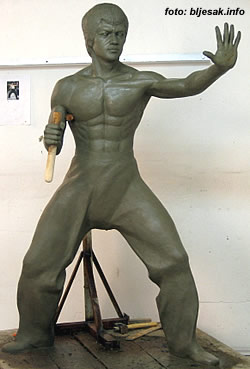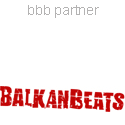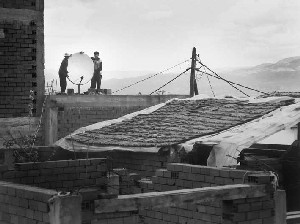Ob durch Identitätspolitik oder durch die individuelle Besetzung von Stadtraum - Stadt wird in Südosteuropa auf besondere Weise angeeignet und kolonisiert. Verschiedenste Unternehmer/innen und Netzwerke sind daran beteiligt – von nationalistischen Eliten, Wirtschaftsunternehmen bis zur Roma-Familie oder Marktfrau. Stadt wird somit zunehmend durch private Agenden geprägt, während die Ermittlung eines „gesellschaftlichen Interesses“ an der Stadt aufgrund der Dekomposition von Kommunen schwieriger wird.
Die Diskussion orientiert sich an folgenden Fragen:
- 15 Jahre nach Zusammenbruch der real-sozialistischen Systeme in Südosteuropa - wem gehört die Stadt? Eine Bestandsaufnahme als Ausgangspunkt der Diskussion.
- Inwieweit tragen Aneignungsstrategien archaischen, anomen oder gleichzeitig auch emanzipatorischen Charakter?
- Liegen in dem gegenwärtigen Verhältnis von „‘use and misuse’, ‘give and take’, ‘steal and mutate’“ (Aksamija) produktive Chancen oder ist dies eine zynische Vernachlässigung von ungleichen Startbedingungen beim Landraub?
Workshop in engl. Sprache, um Anmeldung wird gebeten
recommended links:
- wildcity - structural analysis of Belgrade (stealth group)
This website looks chaotic at the first glimpse, but after browsing through it will unfold an instructing documentation along with a most astonishing analysis of Belgrade's urban development of the last decade. Not to be missed!
- A brief history of Turbo Architecture (Srdjan Jovanovic Weiss)
Turbo Architecture hat sich als Begriff erst kürzlich herausgebildet und bezeichnet Gebäude einer mutierten Art, die eine Verschmelzung aus mittelalterlichen Formen (z.B. byzantinisch) mit den Mitteln und den Anforderungen der zeitgemäßen technologischen Ästhetik (z.B. High - Tech) ausführt. Er bezeichnet außerdem das riesige Ausmaß an architektonischer Produktion während der Krise in Belgrad, analog zum Begriff "turbo" in der Automobilindustrie - schnellere Autos, aber in bestehenden oder gebrauchten Karosserien, mit höherem Wert. Außerdem ist Turbo Architecture eine direkte urbane Entsprechung zum Turbo Folk, einem sehr populären musikalischen Genre in Serbien in den 90er Jahren. Seine Besonderheit sind die freien Anleihen aus traditionellen und aktuellen Quellen, was zu einem fortwährenden Mix aus Technorhythmen und traditionellen Melodien führte. Die Produzenten von Turbo Folk nutzten die Isolation Serbiens zur Zeit des Krieges zu ihrem Vorteil. Sie kopierten und luden Musik aus allen nur erdenklichen Quellen herunter, während Copyright-Gesetze nur außerhalb dieser Isolation galten. Parallel dazu wurden zu dieser Zeit hunderte und tausende von Häusern in einem halsbrecherischen Tempo errichtet, noch vor dem offiziellen Wiederaufbau. Ganze Familien von architektonischen Formen aller Größen, von Einzelhäusern bis hin zu riesigen Komplexen, bilden nun einen neue populäre Identität der Stadt - ein besonderer Zustand, hervorgegangen aus einer politischen Krise gepaart mit einem raschen Wachstum. Das ist der Fokus dieser Arbeit.
- balkanization of Deutsche Bank (school of missing studies)
The term: Balkanization emerged in response to small scale independence movements in the Balkans and describes the process of geopolitical fragmentation. It is used to depict any kind of political dissolution across the world in order to sustain. The term has also expanded to connote a varied tableau of scenarios involving fragmentation, such as "the balkanization of the Internet" or “the balkanization of America,” coming out of an extreme right wing voices that ‘care’ about the sustenance of the society. Furthermore, if globalization is the increasing interconnectedness of peoples and places through converging processes of economic, political, and cultural change, then balkanization is a counteraction to the integrating and homogenizing effects of globalization. That effectively means the abolishment of the local in exchange for the balkanized, which truly shifts the meaning of the originally negative and hostile term of balkanization as well as advances the reach of the term local. Technically looking, conceived of as "centrifugal" forces, separatist or balkanizing pressures act to undermine or divide, as they pull outward and away from the center. Conversely, "centripetal" forces function to reinforce and augment unity and the power. Balkanization occurs when the centrifugal forces outweigh the centripetal forces within.
- Europe Lost and Found [ELF]
ELF is organized by the group of international artists and architects for the period of 2006-2009: Azra Aksamija, Srdjan Jovanovic Weiss, Kyong Park and Marjetica Potrc.
"Europe: Lost and Found is a multidisciplinary research project that contemplates the future of Europe by exploring the geography of its states and regions, communities and individuals. It will unfold with a mass expedition of several hundreds intellectuals over the Western Balkan taking place in the summer 2006. This intelligent swarm will carry out a comparative exploration of Europeís hybrid landscapes and parallel economies. Through analysis and visual documentation of urban and cultural phenomena, dynamic and SMS based mappings, interdisciplinary research projects, discussion forums as well as independent studies, it will look for inventions toward a positive co-existence for the future of Europe. The project will then commission new works in art, architecture and other visual language based fields to be presented in a traveling exhibition, conferences, workshops, publications and internet. Aiming to become a self-organized stateless state, ELF will act as a moving city and a nomadic university, which is open to experts of various fields and the general public."
Urban Movement Mostar has existed since 1999 while its Association was registered in June 2001, with the permanent membership of 30-50 from all over the world (France, Australia, Sweden and the U.S.A., but mainly from Mostar). Our members are students, intellectuals, workers and pensioners...
The goals of Urban Movement are to develop critical mind and individual thinking, to demystify newly established national values and the media, to overcome national mythologies, to raise public awareness on the relevance of public good, and to put an end to urban devastation.
The tools used by the Urban Movement initiative are radio, television, press, literature, and various artistic actions. Urban Movement has realized numerous actions, such as the cycle of radio programs "Walking down the Victims of Democracy Street", the exhibition entitled "Beauty of Reconstruction and Construction" that was presented in France (Chambery, Lyon and Grenoble), satirical tales, etc.
The initiative to construct the monument commemorating Bruce Lee in Mostar began with an open public debate on the "Monument to Bruce Lee", held on 20th July 2003, on the anniversary of the death of the "man who has been simply loved by everyone". The proponents of this initiative accentuate, as one of the reasons to build the monument, that there was a great deals of our lives, in the times when politics and ideology has poisoned all pores of everyday life, the memories of our childhood and of true human values that had nothing to do with politics and the "grand causes". Today, when all the moral values have collapsed, when children walk around armed with guns, criminals being their role models, the monument to Bruce Lee in the heart of the City of Mostar would be a reminder of children's' dreams of a more just world where sheer force would not be the value that matters, but rather the skill, speed and power of will of the man who fought for justice.
Confident of our noble mission that brings back to the streets - wherefrom it actually originated - a popular icon, a champion of justice whose ethnic background is absolutely irrelevant to us all, we - the boys and the girls from Urban Movement Mostar - see the statue of Bruce Lee, cast in bronze, in his original size and in his typical martial-art posture, set on a low podium, and with the fountain from which only those who stoop low enough to pay tribute to the great hero would be able to drink water.
"I hate to tell people that I am from Mostar since they immediately ask me whether I am from East, i.e., Bosniak, or from West, i.e., Croat Mostar. That is one of the main reasons for building this monument. We hope that one day people would say: Yeah, I know Mostar. That's the city with the Bruce Lee monument. (Nino Raspudic)*
*Excerpts from the texts from the www.bljesak.info website


